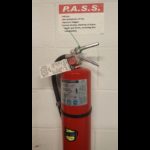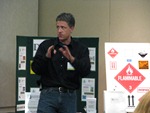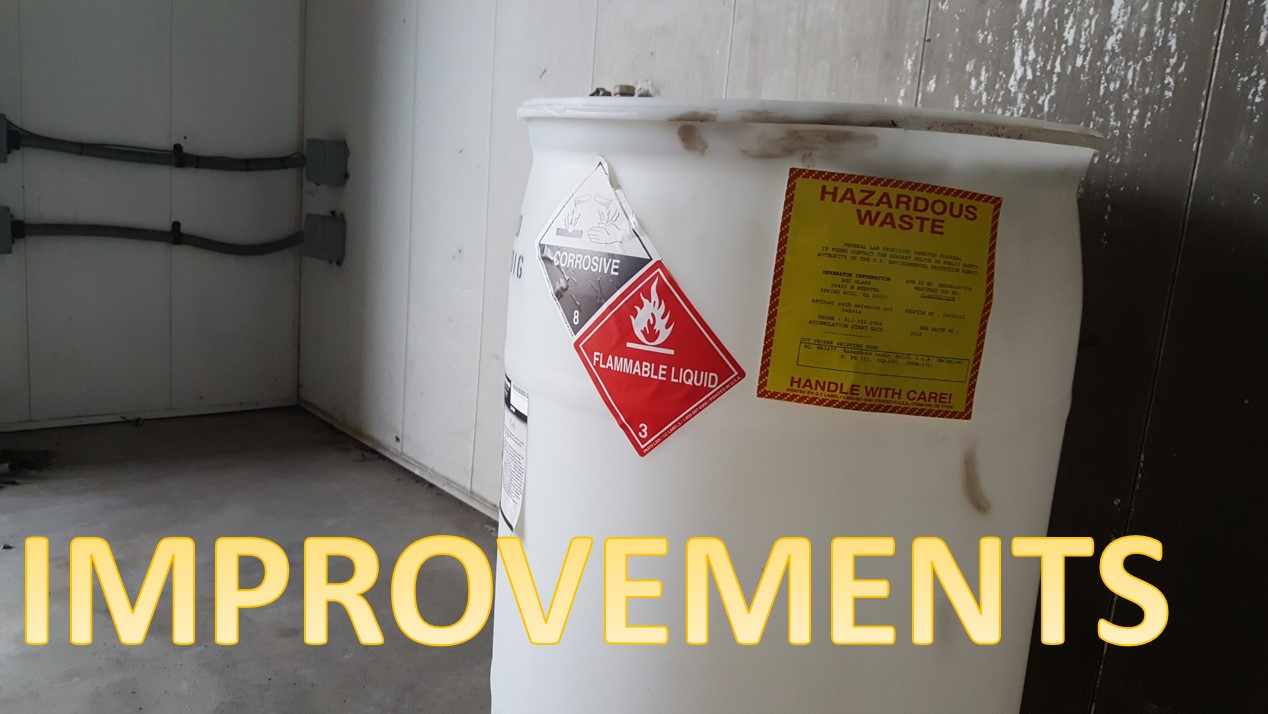Federal regulations of the U.S. Environmental Protection Agency (USEPA) at 40 CFR 262.17(a)(6) require a large quantity generator of hazardous waste (LQG) to comply with the preparedness, prevention, and emergency procedure standards of 40 CFR 262, subpart M. This article is the third in a series that looks closely at each of the sections in subpart M to clearly describe the responsibilities of a LQG.
The purpose of this article is to address the requirements of 40 CFR 262.252 Required equipment.
Before we begin…
These regulations were revised by the Generator Improvements Rule. If your state has not yet adopted the new rule you must continue to comply with the earlier version until it does. You may read an article explaining the earlier version of the regulations (prior to implementation of the Generator Improvements Rule) here.
Not sure of your hazardous waste generator status? |
Scope and Applicability:
These regulations are applicable to a LQG. The requirements of a small quantity generator of hazardous waste (SQG) are almost exactly the same. If you are a SQG please refer to this article for your version of these regulations: Emergency Preparedness and Prevention for Small Quantity Generator: Required Equipment (This article is not yet written. Please be patient.)
As made clear by §262.250 (revised by the Generator Improvements Rule), the preparedness, prevention, and emergency procedures of Subpart M are applicable to those areas of a LQG where hazardous waste is generated or accumulated. This includes:
- Central Accumulation Area (CAA)
- Satellite Accumulation Area (SAA)
Read: Applicability of Preparedness, Prevention, and Emergency Procedures for LQG
40 CFR 262.252 reads:
All areas deemed applicable by §262.250 must be equipped with the items in paragraphs (a) through (d) of this section (unless none of the hazards posed by waste handled at the facility could require a particular kind of equipment specified below or the actual hazardous waste generation or accumulation area does not lend itself for safety reasons to have a particular kind of equipment specified below). A large quantity generator may determine the most appropriate locations within its facility to locate equipment necessary to prepare for and respond to emergencies:
(a) An internal communications or alarm system capable of providing immediate emergency instruction (voice or signal) to facility personnel;
(b) A device, such as a telephone (immediately available at the scene of operations) or a hand-held two-way radio, capable of summoning emergency assistance from local police departments, fire departments, or state or local emergency response teams;
(c) Portable fire extinguishers, fire control equipment (including special extinguishing equipment, such as that using foam, inert gas, or dry chemicals), spill control equipment, and decontamination equipment; and
(d) Water at adequate volume and pressure to supply water hose streams, or foam producing equipment, or automatic sprinklers, or water spray systems.
Why the change?
The big change to this section is found in the introductory language (more on that below). USEPA made these changes based on 30 years of experience with the rules, feedback from stakeholders, and other discussions with stakeholders. USEPA noted that regulations prior to the Generator Improvements Rule were unclear regarding whether the required emergency response equipment must be placed in those areas of operation where hazardous waste is generated and accumulated or other parts of the facility where hazardous waste is not generated or accumulated.
USEPA also noted that it may not always be appropriate or safe to store equipment in the actual waste generation or accumulation area – even though the requirement itself applies only to the generation and accumulation (and treatment, as appropriate) of hazardous waste.
Interested in site specific training at your site that covers this topic, and more! Ask me about my Onsite Training |
Placement of required equipment:
As noted above, this is the big change to this section of the regulations and it will have a significant effect on the LQGs decision on where to place the required equipment (more on that below).
Let’s take a closer look at the wording, terms, and phrases used in the introductory paragraph of §262.252:
“All areas deemed applicable by §262.250…” That brings us back to the first section of this subpart and its establishment of the applicability of these regulations. You can read the full article: The Requirements of 40 CFR 262.250 Applicability of Preparedness, Prevention, and Emergency Procedures for Large Quantity Generators of Hazardous Waste. Suffice to say the areas deemed applicable by §262.250 are those areas of a LQG where hazardous waste are generated or accumulated. This includes central accumulation areas (CAAs), satellite accumulation areas (SAAs), areas where allowable treatment takes place, and areas where hazardous wastes are stored prior to off site transportation.
 “…(unless none of the hazards posed by waste handled at the facility could require a particular kind of equipment specified below…” This language is unchanged from the regulations prior to the Generator Improvements Rule. If for example the waste handled at your facility does not present a fire hazard – e.g., hydrochloric acid – you may not require any of the fire control equipment specified in paragraphs (c) and (d).
“…(unless none of the hazards posed by waste handled at the facility could require a particular kind of equipment specified below…” This language is unchanged from the regulations prior to the Generator Improvements Rule. If for example the waste handled at your facility does not present a fire hazard – e.g., hydrochloric acid – you may not require any of the fire control equipment specified in paragraphs (c) and (d).
“…or the actual hazardous waste generation area…” This text is new and reflects USEPA’s determination that the LQG should have the flexibility to store its equipment in other areas of the facility in situations where it is unsafe to have the equipment located immediately next to the hazardous waste generation or accumulation areas. Even though the requirement to equip areas of the facility with emergency equipment applies to the areas of hazardous waste generation and accumulation, the LQG – under these new regulations – may choose to store the required equipment somewhere else besides in the immediate areas of hazardous waste generation and accumulation.
Note that an LQG using this particular exception from the requirement to equip areas of the facility where hazardous waste are generated or accumulated must do so due to “safety reasons” and not reasons of inconvenience or cost. The LQG had better be able to demonstrate a legitimate reason based on safety concerns that the required equipment was not in the areas deemed applicable by §262.250.
Contact me with any questions you may have about the generation, identification, management, and disposal of hazardous waste Daniels Training Services, Inc. 815.821.1550 |
“A large quantity generator may determine…” Also new to these revised regulations. This condition is separate from the first two. It is meant to provide flexibility for the LQG in determining the most appropriate locations of emergency response equipment. This may be a “two-edged sword” for the LQG because the regulations now state it is only the LQG that has the ability to determine the appropriate locations of emergency response equipment (subject to the approval of your federal or state inspector, naturally!)
In sum, the introductory paragraph communicates the following:
- All areas of a LQG where hazardous waste are generated or accumulated must be equipped with the required emergency response equipment.
However…
- Emergency equipment is not required at all if the none of the hazardous waste handled by a LQG pose the hazards addressed by the emergency response equipment. i.e., no fire threat, no fire suppression equipment.
And…
- Emergency equipment may be required but not placed in the area of hazardous waste accumulation or generation if the LQG believes it unsafe to do so.
And finally…
- The appropriate location for emergency response equipment within its facility is to be determined by the LQG.
Keep those conditions in mind while we continue through this section to identify and explain the required equipment.
The required equipment:
“An internal communications or alarm system…”
- For use within the facility.
- May be a system that communicates information (e.g., a public address or intercom) or an alarm.
- Must provide immediate emergency instruction by voice or signal. That is, it must tell facility personnel what they must do in an emergency. This could be done by a live or pre-recorded voice speaking instructions or it could be an alarm system (signal) to which trained personnel know how to respond.
Q: May an internal communications or alarm system be designated personnel who move throughout the facility in an emergency informing and instructing other personnel?
A: Yes. Nothing in §262.252 requires the communications or alarm system to be delivered electronically. Nor does it preclude the use of designated personnel who deliver the necessary information in person. Just remember, whatever system used must provide, “immediate emergency instruction”.
“A device, such as a telephone…”
- For external use.
- Capable of summoning emergency assistance from outside the facility:
- Local police departments.
- Fire departments.
- State or local emergency response teams.
- The device may be any of the following:
- A telephone if it is immediately available in the area(s) where hazardous waste are generated or accumulated, i.e., “…at the scene of operations…”
- A hand-held two-way radio presumably in the possession of hazardous waste personnel.
- Some other device capable of summoning emergency assistance from outside the facility. While two examples of an acceptable device are provided: telephone and hand-held two-way radio, compliance is not restricted to just these two.
“Portable fire extinguishers…”
- Specific equipment is not indicated but at a minimum the following should be considered:
- Portable fire extinguishers.
- Fire control equipment to address special fire hazards, such as those using:
- Foam
- Inert gas
- Dry chemicals
And not just fires…
- Spill control equipment.
- Decontamination equipment for facility personnel.
“…and water at adequate volume…”
- A very subjective part of the regulations. “…adequate…”(?!). LQG must determine if it has water at adequate volume and pressure to supply the following fire suppression equipment:
- Water hose streams
- Foam producing equipment
- Automatic sprinklers
- Water spray systems
In short: hooking up to your local water supply may not be enough.
Is that it?

No. First of all, as a LQG you must still comply with the remaining requirements of §262, subpart M as revised by the Generator Improvements Rule.
And then, what about training? At §262.17(b)(7) – directly following the referral to emergency procedures – are the training requirements for a LQG. §262.17(b)(7)(i)(C) reads in part:
At a minimum, the training program must be designed to ensure that facility personnel are able to respond effectively to emergencies…
So clearly, Hazardous Waste Personnel Training at a LQG is important.

